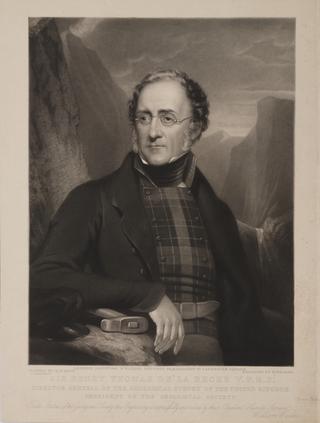
Sir Henry Thomas De la Beche 1796 - 1855
- Nationality:
- English; British
- born in:
- London, Greater London, England, United Kingdom
De la Beche was a key player in establishing geology as a profession, founded several of Britain’s major geological institutions, and made significant contributions of his own to scientific knowledge particularly aided by his illustrations. His early career was funded by his family’s ownership of slave plantations, later becoming a government employee.
He spent his early years in Lyme Regis, where friendship with Mary Anning inspired his geological interest. He was the son of naval officer, Thomas de la Beche, from whom he inherited estates and enslaved people in Jamaica, with the main income coming from sugar and rum. On turning 21 in 1817, he was able to receive the income from the plantations, which provided the independent means to pursue his geological interests.
De la Beche visited his estate in Jamaica in 1823-1824 which resulted in two publications. Firstly, in 1825, ‘Notes on the Present Condition of the Negroes’ aimed to describe ‘objectively’ the conditions of enslaved people on his estate but presented a very idealised situation. He opposed abolition arguing instead for a gradual change. In 1827, he published his geological account of Jamaica with a description and coloured map, helping to establish his career and gaining him the title ‘Father of Jamaican geology'.
On return from Jamaica, De la Beche started a survey of geology in Devon and Cornwall. Reduced revenue from his slave plantations led him to apply to the government for financial assistance to complete the project. This moved him to a career as a professional geologist and growing prestige. He became a Fellow of the Royal Society in 1819, director of the new Geological Survey of Great Britain in 1835 and was knighted in 1842. In quick succession he became director of the Museum of Practical Geology (1843), the first President of the Palaeontographical Society (1847), and President of the Geological Society of London (1848-1849). In 1851 he became director of a larger establishment combining Geological Survey, the Museum of Practical Geology, the Royal School of Mines and the Mining Record Office.
De la Beche’s clear, simple illustrations are widely regarded as contributing to the success of his publications. He also produced a number of famous images, including ‘Duria Antiquior (A More Ancient Dorset)’ in 1830, the first well-known image of deep time. This watercolour sketch showed Mary Anning's key fossil finds and gave her financial support through the sale of lithographs.
On his death the De la Beche medal was created for students at the Royal College of Mines and other institutions. The medal was the second imprint of a medal De la Beche originally had engraved and struck for the slaves on his plantation. By William Wyon of the Royal Mint, the medal showed De la Beche's portrait on one side, and the plantation on the other, replaced with crossed hammers for the School of Mines.
